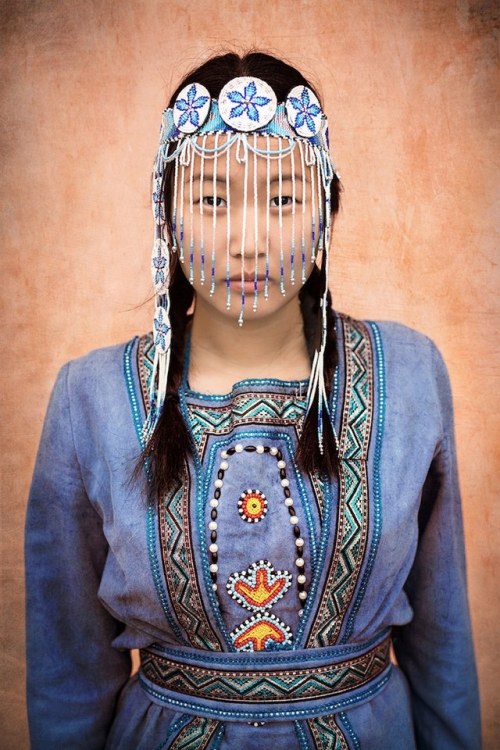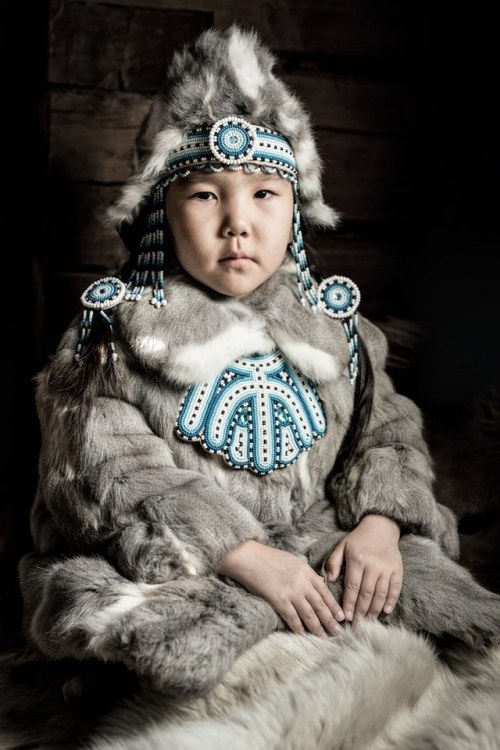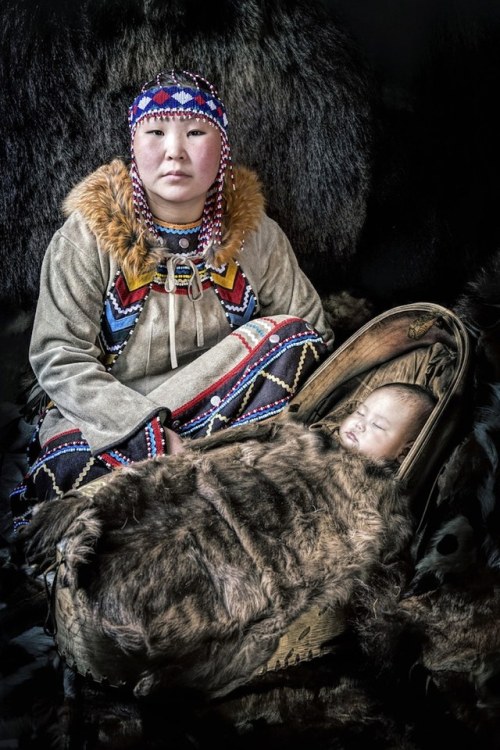Evenki people, photos by Alexander Khimushin1. Evenki girl, Republic of Buryatia, Siberia2. Evenki g
Evenki people, photos by Alexander Khimushin1. Evenki girl, Republic of Buryatia, Siberia2. Evenki girl, Sakha Republic, Siberia3. Evenki mother and child, Sakha Republic, SiberiaThe Evenks (also spelled Ewenki or Evenki) are a Tungusic people of Northern Asia. In Russia, the Evenks are recognised as one of the indigenous peoples of the Russian North, with a population of 38,396 (2010 census). In China, the Evenki form one of the 56 ethnic groups officially recognised by the People’s Republic of China, with a population of 30,875 (2010 census). There are 537 Evenks in Mongolia (2015 census).Traditionally they were a mixture of pastoralists and hunter-gatherers—they relied on their domesticated reindeer for milk and transport and hunted other large game for meat (Vasilevich, 620-1). Today “[t]he Evenks are divided into two large groups…engaging in different types of economy. These are the hunting and reindeer-breeding Evenks…and the horse and cattle pastoral Evenks as well as some farming Evenks” (620). The Evenks lived mostly in areas of what is called a taiga, or boreal forest. They lived in conical tents made from birch bark or reindeer skin tied to birch poles. When they moved camp, the Evenks would leave these frameworks and carry only the more portable coverings. During winter, the hunting season, most camps consisted of one or two tents while the spring encampments had up to 10 households (Vasilevich, 637).Their skill of riding the domesticated reindeer allowed the Evenks to “colonize vast areas of the eastern taiga which had previously been impenetrable” (Vitebsky, 31). The Evenks used a saddle unique to their culture which is placed on the shoulders of the reindeer so as to lessen the strain on the animal, and used not stirrups but a stick to balance (31-32). Evenks did not develop reindeer sledges until comparatively recent times (32). They instead used their reindeer as pack animals and often traversed great distances on foot, using snowshoes or skis (Vasilevich, 627). The Evenki people did not eat their domesticated reindeer (although they did hunt and eat wild reindeer) but kept them for milk. (Forsyth, 49-50).The Evenks wore a characteristic costume “adapted to the cold but rather dry climate of Central Siberia and to a life of mobility…they wore brief garments of soft reindeer or elk skin around their hips, along with leggings and moccasins, or else long supple boots reaching to the thigh” (49). They also wore a deerskin coat that did not close in front but was instead covered with an apron-like cloth. Some Evenkis decorated their clothing with fringes or embroidery (50). The Evenki traditional costume always consisted of these elements: the loincloth made of animal hide, leggings, and boots of varying lengths (Vasilevich, 641). Facial tattooing was also very common.^Evenks in 1862In the 17th century, the Russian empire made contact with the Evenks. Cossacks, who served as a kind of “border-guard” for the tsarist government, imposed a fur tax on the Siberian tribes. The Cossacks exploited the Evenk clan hierarchy and took hostages from the highest members in order to ensure payment of the tax. Although there was some rebellion against local officials, the Evenks generally recognized the need for peaceful cultural relations with the Russians (Vasilevich, 624). Contact with the Russians and constant demand for fur taxes pushed the Evenks east all the way to Sakhalin island, where some still live today (Cassells). In the 19th century some groups migrated south and east into Mongolia and Manchuria (Vasilevich, 625). Today there are still Evenk populations in Sakhalin, Mongolia, and Manchuria (Ethnologue), and to a lesser extent, their traditional Baikal region (Janhunen). Russian invasion of the Evenks (and other indigenous peoples) resulted in language erosion, traditional decline, identity loss, among others, of thereof. This was especially the case during the Soviet regime. Soviet policies of collectivization, forced sedentarization (or sometimes refer to as Sedentism), “unpromising villages”, and Russificationof the education system compromised social, cultural, and mental well-being of the Evenks . Today, few people can speak the Evenki language, reindeer herding is in significant decline, the suicide rate is extremely high, and alcoholism is a serious issue.(source) -- source link
Tumblr Blog : sartorialadventure.tumblr.com
#fashion#evenks#evenki fashion#siberia#siberian fashion


